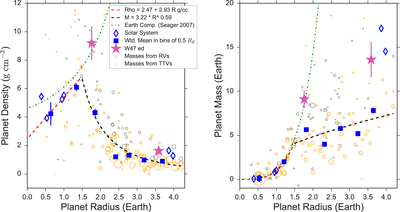Image Details

Caption: Figure 8.
Left: planet density vs. planet physical radius for 94 transiting planets smaller than ﹩4.2\,{R}_{\oplus }﹩. The gray circles have masses determined from RVs; the gold circles have masses determined from TTVs. The size of the circle corresponds to 1/﹩{\sigma }_{\rho }^{2}﹩. Blue squares show the weighted mean density in bins of ﹩0.5\,{R}_{\oplus }﹩ to guide the eye. The blue diamonds are the solar system planets. The red dashed line is an empirical linear fit to planet density vs. radius for the exoplanets and solar system planets smaller than ﹩1.5\,{R}_{\oplus }﹩, extended to predict the densities of potentially rocky planets larger than ﹩1.5\,{R}_{\oplus }﹩. For comparison, we show the predicted density–radius curve for a polytropic equation of state of an Earth-composition planet (Seager et al. 2007, green dotted line). The black line is an empirical power-law fit to planet mass vs. radius for planets larger than ﹩1.5\,{R}_{\oplus }﹩. WASP-47 e (﹩1.9\,{R}_{\oplus }﹩) sits on the red line and therefore is consistent with a rocky composition, but could also have a thin volatile envelope. WASP-47 d (﹩3.7\,{R}_{\oplus }﹩) has a density that requires significant volatiles, including the possibility of high-density volatiles based on the similarity of its bulk properties to Uranus and Neptune. Right: Same as the left panel, but showing planet mass vs. radius, and the circle sizes correspond to ﹩1/{\sigma }_{m}^{2}﹩.
Copyright and Terms & Conditions
© 2017. The American Astronomical Society. All rights reserved.












